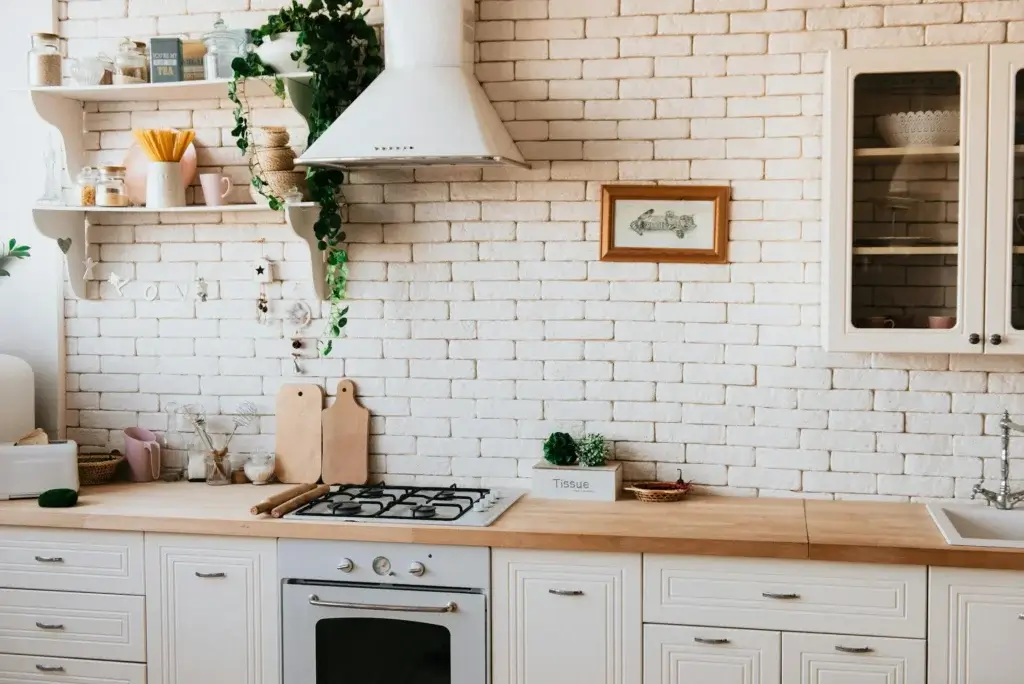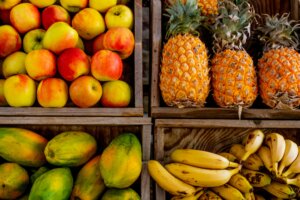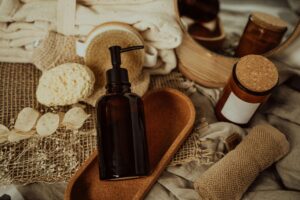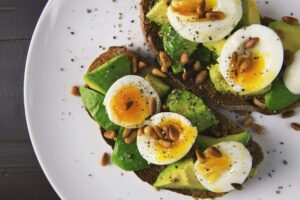Creating a low tox kitchen is a foundational step toward reducing exposure to harmful chemicals and fostering a low tox home. Many everyday kitchen items, from cookware and utensils to cleaning supplies and storage containers, can introduce toxins into your food, air, and water. These toxins, such as PFAS, BPA, phthalates, and synthetic fragrances, may have long-term health effects.
Fortunately, transitioning to a low tox kitchen doesn’t need to happen overnight. By making informed choices and tackling one area at a time, you can transform your kitchen into a safer, healthier space.
Here’s a detailed guide—broken down into ten steps—to help you create a low tox kitchen, complete with practical (and realistic) tips to get started.
Step 1: Replace non-stick cookware with safer alternatives
Non-stick cookware, while convenient, often contains harmful chemicals like PFAS (commonly found in Teflon) that can release toxic fumes when heated. These chemicals are linked to health issues such as hormonal disruptions, developmental delays, and potential carcinogenic effects. This is especially concerning if the non-stick surface is scratched or damaged.
By switching to safer cookware, you eliminate this risk and invest in healthier cooking practices.
- Invest in cast iron skillets, which, when seasoned correctly, develop a natural, durable non-stick surface. They are great for high-heat cooking and last a lifetime with proper care.
- Choose stainless steel cookware, which is non-reactive, long-lasting, and perfect for sautéing, boiling, and frying.
- Consider ceramic-coated pans, but ensure they are from reputable brands that use non-toxic coatings free of heavy metals and synthetic chemicals.
How to get started: Begin by replacing your most-used non-stick pans, especially if they’re scratched or peeling. Gradually transition to a full set of safe cookware as your budget allows.
Step 2: Switch to glass or stainless steel food storage containers
Plastic food storage containers are often made with chemicals like BPA or phthalates, which can leach into your food, particularly when exposed to heat, acidic foods, or oils. These chemicals are endocrine disruptors and have been linked to fertility issues, metabolic disorders, and even certain cancers.
Replacing plastic containers with non-toxic options is an easy way to reduce exposure.
- Use glass containers for storing and reheating food. Glass is microwave, oven, and freezer safe, and it doesn’t absorb food odors or stains.
- Opt for stainless steel lunchboxes, which are lightweight, durable, and perfect for transporting meals.
- If you must use plastic containers, ensure they are BPA-free and never heat food in them.
How to get started: Start with a small set of glass containers and prioritize replacing the containers you use daily for leftovers or meal prep.
Step 3: Ditch plastic utensils and cutting boards
Every time you use plastic utensils or cutting boards, tiny plastic particles may shed into your food, especially when exposed to heat or knife cuts. Over time, this can lead to microplastic ingestion, which is increasingly being linked to health concerns such as inflammation and oxidative stress.
Wooden and bamboo options are not only safer but also more durable and aesthetic.
- Replace plastic utensils with wooden or bamboo utensils, which are naturally free of harmful chemicals and gentle on cookware.
- Use wooden cutting boards, which have natural antimicrobial properties and resist bacteria when cleaned properly.
How to get started: Replace frequently used items like spatulas, spoons, and cutting boards first, especially if they show signs of wear or damage.
Step 4: Use natural cleaning products
Most commercial kitchen cleaners are filled with synthetic chemicals, such as ammonia, chlorine, and synthetic fragrances, that can irritate your skin, lungs, and eyes. These products can also leave behind residues that contaminate your surfaces and cooking spaces.
Switching to natural alternatives ensures your kitchen stays clean without introducing unnecessary toxins.
- Replace all-purpose cleaners with a DIY mix of white vinegar, water, and essential oils like lemon or tea tree for added antibacterial benefits.
- Use baking soda as a gentle abrasive for scrubbing tough stains on countertops or stovetops.
- Consider natural cleaning brands that use biodegradable, non-toxic ingredients.
How to get started: Replace one product at a time, starting with the cleaners you use most often, such as dish soap or countertop sprays.
Step 5: Install a water filter
Drinking and cooking with tap water can expose you to contaminants like chlorine, pesticides, heavy metals, and even microplastics. Installing a water filter reduces these risks, ensuring your water is clean and safe for your family.
The type of filter you need depends on the quality of your local water supply.
- Use a pitcher filter, such as Brita or ZeroWater, for an affordable, portable solution.
- Install an under-sink reverse osmosis system for more comprehensive filtration that removes a wider range of contaminants.
- Consider a filter for your refrigerator’s water dispenser and ice maker, as these are often overlooked.
How to get started: Check your local water quality report to identify the contaminants present and choose a filter that addresses your specific needs.
(Check out our post on choosing the right water filter.)
Step 6: Upgrade cookware accessories
Accessories like spatulas, baking sheets, and muffin tins may not seem like a major source of toxins, but plastic utensils and non-stick bakeware can still introduce harmful chemicals into your food.
Choosing safer materials ensures peace of mind.
- Avoid silicone baking mats, as they can degrade at high temperatures, and opt for unbleached parchment paper instead.
- Replace plastic spatulas and spoons with stainless steel, wooden, or bamboo alternatives.
- Choose bakeware made of glass, stainless steel, or ceramic.
How to get started: Replace the utensils and bakeware you use most often and focus on phasing out non-stick or plastic items.
Step 7: Adjust your cooking methods
The way you prepare food can also impact your exposure to toxins. High-heat cooking methods, like frying, can produce harmful compounds like acrylamide in starchy foods or polycyclic aromatic hydrocarbons (PAHs) in charred meat.
Switching to gentler methods reduces these risks.
- Avoid deep frying and instead use techniques like steaming, baking, or boiling to prepare your meals.
- Cook with high-quality, stable oils, such as extra virgin olive oil or avocado oil, which are less likely to break down into harmful compounds.
- Trim charred bits from grilled or roasted foods to reduce exposure to PAHs.
How to get started: Experiment with one new cooking method each week, such as steaming vegetables or baking instead of frying.
Step 8: Use low tox dish soap and scrubbers
Dish soap and sponges are everyday items, but many conventional options contain artificial fragrances, dyes, and other harmful ingredients. These products may leave residues on your dishes or break down into microplastics, which can enter the water supply.
Switching to non-toxic alternatives makes dishwashing safer for you and your family.
- Choose plant-based, fragrance-free dish soaps made with natural ingredients.
- Use biodegradable sponges or silicone scrubbers that last longer and reduce waste.
How to get started: Start by replacing your dish soap with a natural brand and explore reusable scrubber options like bamboo or coconut fiber brushes.
Step 9: Stock your pantry with healthier options
Pantry staples can be a hidden source of toxins due to packaging, preservatives, or pesticide residues. Prioritizing fresh, organic, and minimally processed ingredients reduces your family’s exposure to these chemicals.
- Choose organic produce whenever possible to avoid pesticide exposure.
- Avoid canned foods with BPA-lined lids and opt for brands that use glass jars or BPA-free packaging.
- Buy bulk staples like grains, nuts, and seeds to minimize waste and additives.
How to get started: Replace pantry staples with healthier options as you use them up, starting with frequently consumed items like grains or canned goods.
Step 10: Improve kitchen ventilation
Cooking, especially on gas stoves, can release pollutants like nitrogen dioxide and carbon monoxide into the air. Without proper ventilation, these toxins can accumulate, potentially affecting respiratory health.
Good ventilation ensures your kitchen air stays fresh and safe.
- Use your range hood whenever you cook, ensuring it vents outdoors rather than recirculating air.
- Open windows during and after cooking to let in fresh air.
- Consider adding an air purifier with a HEPA filter to capture airborne particles and odors.
How to get started: Clean your range hood filters regularly and remember to use it every time you cook, especially when frying or sautéing.
Ready to low tox your kitchen?
Transforming your kitchen into a low tox space is an ongoing process that rewards you with a healthier home and peace of mind. Tackle one step at a time, starting with the areas that feel most manageable or impactful. Over time, these small, deliberate changes add up to create a safe, toxin-free environment where you can enjoy cooking and sharing meals with loved ones.







